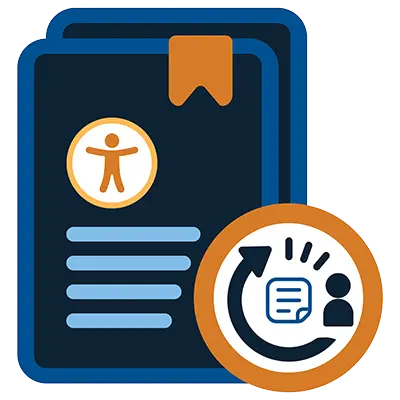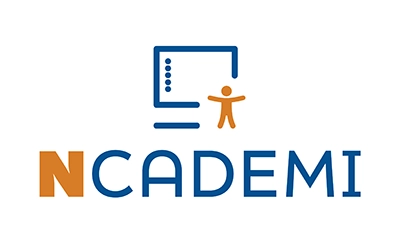
Statement
The state and local educational agencies (SEA and LEAs) provide guidelines that support the timely acquisition of high-quality accessible formats.
Intent
When the IEP team determines that a student needs an accessible format to access the materials used in the general education curriculum, the SEA or LEA is responsible for providing those educational materials in the format(s) required by the student in a timely manner. The amount of time it can take to acquire an accessible format varies widely, depending on the format required and whether the material has already been produced in the needed format by one or more organizations. Federally funded programs are available to help SEAs and LEAs meet the IDEA’s requirement to provide accessible formats to a student with a disability in a timely manner.
Critical Components
To effectively address Quality Indicator AF4, the following components should be present:
AF4.1 Acquisition Guidelines
Guidelines for initiating the process of acquiring accessible formats as early as possible.
- The search for accessible formats of educational materials needed by a student must begin as soon as possible following the development of the IEP.
- Because braille materials can take months to produce, agencies should consider placing orders from accessible media producers (AMPs) at least six months in advance of the date needed.
AF4.1 Self-Assessment Scoring Matrix
| Not Started | Emerging | Operationalizing | Scaling & Sustainability |
|---|---|---|---|
| The need to provide guidelines for initiating the process of acquiring accessible formats as early as possible has not yet been considered. | The SEA is reviewing current acquisition timelines. In partnership with the State AEM Contact, the SEA assesses how long it takes to provide high-quality accessible materials by format type (e.g., braille, audio, large print, digital text, tactile graphics). The SEA is beginning to draft guidance on early acquisition of accessible formats. | The SEA has drafted guidelines on early acquisition by format type. The guidelines include placing orders for braille materials from AMPs at least six months in advance of the date needed. LEAs have access to draft guidelines and some IEP teams are referring to the guidelines for prompt acquisition. Feedback is being collected to improve the guidelines. | The SEA issues clear, actionable guidelines for acquiring all accessible format types as early as possible to ensure students have access in a timely manner. IEP teams consistently apply the guidelines. The SEA regularly reviews and updates the guidelines, ensuring they remain aligned with best practices and evolving regulations. |
The scoring matrix is part of the Quality Indicator Self-Assessment Tools.
AF4.2 Guidelines Include Funded Sources of Accessible Formats
Guidelines include a description of federally and state-funded sources of accessible formats, including information about:
- Bookshare, an OSEP-funded project that provides a range of accessible digital formats at no cost to schools and families of eligible students
- The state’s Instructional Resource Center (IRC), which typically maintain a library of accessible formats and manage requests for materials for eligible students, can be accessed through State AEM Contacts
- The Federal Quota Program, through which states are allocated annual funds to purchase specialized educational materials from the American Printing House for the Blind, including but not limited to braille and large print
- The Louis Database of Accessible Materials, in which accessible formats from over 50 organizations can be searched
- The National Library Service for the Blind and Print Disabled (NLS) and its network of State libraries, which provide braille and audio
- The Described and Captioned Media Program (DCMP), an OSEP-funded project that provides accessible educational videos at no cost to schools and families of students with disabilities
AF4.2 Self-Assessment Scoring Matrix
| Not Started | Emerging | Operationalizing | Scaling & Sustainability |
|---|---|---|---|
| The need to provide guidelines that include a description of state- and federally- funded sources of accessible formats has not yet been considered. | The SEA is reviewing current use of federally and state-funded sources of accessible formats for acquisition by LEAs. Additional sources are being identified with support from the State AEM Contact. The SEA is beginning to draft guidance on sources of accessible formats. | The SEA has drafted guidelines directing LEAs to all identified sources of accessible formats. LEAs have access to draft guidelines and some IEP teams are beginning to acquire accessible formats from at least two of these sources. Feedback is being collected to improve the guidelines. | The SEA issues clear, actionable guidelines outlining sources of accessible formats. IEP teams consistently acquire accessible formats from all federally and state-funded resources as available to ensure timely delivery. The SEA regularly reviews and updates the guidelines, ensuring they remain aligned with best practices and evolving regulations. |
AF4.3 Guidelines for Locally Produced Accessible Formats
Guidelines include a description of options for producing accessible formats locally, including scanning materials and recording audio.
AF4.3 Self-Assessment Scoring Matrix
| Not Started | Emerging | Operationalizing | Scaling & Sustainability |
|---|---|---|---|
| The need to provide guidelines that describe options for producing accessible formats locally has not yet been considered. | The LEA is reviewing current practices related to local production of accessible formats and are identifying additional options (e.g. apps, software/hardware, device settings). Staff are beginning to coordinate across departments (e.g. special education and instructional technology) to draft guidance on methods for producing accessible formats. | The LEA has drafted guidelines describing options for producing accessible formats locally, such as scanning print materials, recording audio, and converting documents into accessible formats. Schools have access to draft guidelines and some schools are using them to support local creation of accessible formats. Feedback is being collected to improve the guidelines. | The LEA issues clear, actionable guidelines that describe options for locally producing a range of accessible formats. Schools consistently produce accessible formats within their capacity when materials are not available from an AMP. LEAs regularly review and update the guidelines, ensuring they remain aligned with best practices and evolving regulations. |
AF4.4 Guidelines for Copyright Protection
Guidelines include a means for schools to protect copyright by ensuring accessible format files are securely distributed to eligible students.
AF4.4 Self-Assessment Scoring Matrix
| Not Started | Emerging | Operationalizing | Scaling & Sustainability |
|---|---|---|---|
| The need to provide guidelines for protecting copyright of educational materials when distributing accessible formats has not yet been considered. | The SEA is reviewing current copyright practices and is developing guidance for LEAs to ensure secure distribution of accessible format files to eligible students. Some LEAs are providing accessible format files with awareness of copyright protections. | The SEA has drafted guidelines for protecting copyright by ensuring accessible format files are securely distributed to eligible students. The SEA is beginning to communicate the guidelines to LEAs. Some LEAs are integrating the SEA guidelines into their local procedures. | The SEA issues clear, actionable guidelines for protecting the copyright of educational materials through secure distribution of accessible formats to eligible students. LEAs have built copyright protection into their local procedures. These procedures are consistently used for acquiring accessible formats. The SEA regularly reviews and updates the guidelines, ensuring they remain aligned with best practices and evolving regulations. |
